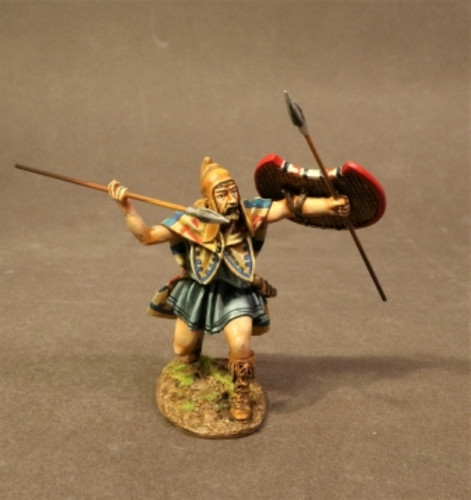John Jenkins Designs
John Jenkins Designs TH-05A Ancients Collection Thracian Peltast 4th Century BC
- SKU:
- TH-05A
- Shipping:
- Calculated at Checkout
John Jenkins Designs TH-05A Ancients Collection Thracian Peltast 4th Century BC. Thracians were a group of Indo-European tribes inhabiting a large area in Eastern and Southeastern Europe. The Thracians in classical times were broken up into a large number of groups and tribes (over 200), though a number of powerful Thracian states were organized, such as the Odrysian kingdom of Thrace and the Dacian kingdom of Burebista. In the first decade of the sixth century BC, the Persians conquered Thrace and made it part of their satrapy Skudra. Thracians were forced to join the invasions of European Scythia and Greece. According to Herodotus, the Bithynian Thracians also had to contribute a large contingent to Xerxes' invasion of Greece in 480 BC. The Thracians were a warrior people,known as both horsemen, but mainly as lightly armed kirmishers with javelins, which were known as peltasts. They were regarded by other peoples as warlike, ferocious, and bloodthirsty. The peltast, was a type of soldier of the ancient period, which probably originated in Thrace. Thracian peltasts were to have a notable influence in Ancient Greece. A Thracian Peltast carried a crescent-shaped wicker shield and was armed with several javelins (akontia). The style of fighting used by peltasts probably originated in Thrace and the first peltasts used by Greek armies were recruited from the Greek cities of the Thracian coast. They are generally depicted on Greek vases and in other images as wearing the typical Thracian costume, which includes the distinctive Phrygian cap made of fox-skin, with ear flaps. They also usually wore a patterned tunic, fawnskin boots and a long cloak, called a zeira, which was decorated with a bright, geometric, pattern. Peltasts gradually became more important in Greek warfare, in particular during the Peloponnesian War. They became the main type of Greek mercenary infantry in the 4th century BC. Their equipment was less expensive than that of traditional hoplites and would have been more readily available to poorer members of society. When faced by hoplites, peltasts operated by throwing javelins at short range. If the hoplites charged, the peltasts would retreat. As they carried considerably lighter equipment than the hoplites, they were usually able to evade successfully, especially in difficult terrain. They would then return to the attack once the pursuit ended, if possible, taking advantage of any disorder created in the hoplites' ranks. The Athenian general Iphicrates destroyed a Spartan phalanx in the Battle of Lechaeum in 390 BC, using mostly Thracian peltasts. In the first decade of the sixth century BC, the Persians conquered Thrace and made it part of their satrapy Skudra. Thracians were forced to join the invasions of European Scythia and Greece According to Herodotus, the Bithynian Thracians also had to contribute a large contingent to Xerxes' invasion of Greece in 480 BC. Later the conquest of the southern part of Thrace by Philip II of Macedon in the fourth century BC made the largest Thracian state, the Odrysian kingdom extinct for several years. After the kingdom had been reestablished, it was a vassal state of Macedon for several decades under generals such as Lysimachus of the Diadochi.
Returns Policy
You may return most new, unopened items within 30 days of delivery for a full refund. We'll also pay the return shipping costs if the return is a result of our error (you received an incorrect or defective item, etc.).
You should expect to receive your refund within four weeks of giving your package to the return shipper, however, in many cases you will receive a refund more quickly. This time period includes the transit time for us to receive your return from the shipper (5 to 10 business days), the time it takes us to process your return once we receive it (3 to 5 business days), and the time it takes your bank to process our refund request (5 to 10 business days).
If you need to return an item, simply login to your account, view the order using the "Complete Orders" link under the My Account menu and click the Return Item(s) button. We'll notify you via e-mail of your refund once we've received and processed the returned item.
Shipping
We can ship to virtually any address in the world. Note that there are restrictions on some products, and some products cannot be shipped to international destinations.
When you place an order, we will estimate shipping and delivery dates for you based on the availability of your items and the shipping options you choose. Depending on the shipping provider you choose, shipping date estimates may appear on the shipping quotes page.
Please also note that the shipping rates for many items we sell are weight-based. The weight of any such item can be found on its detail page. To reflect the policies of the shipping companies we use, all weights will be rounded up to the next full pound.












